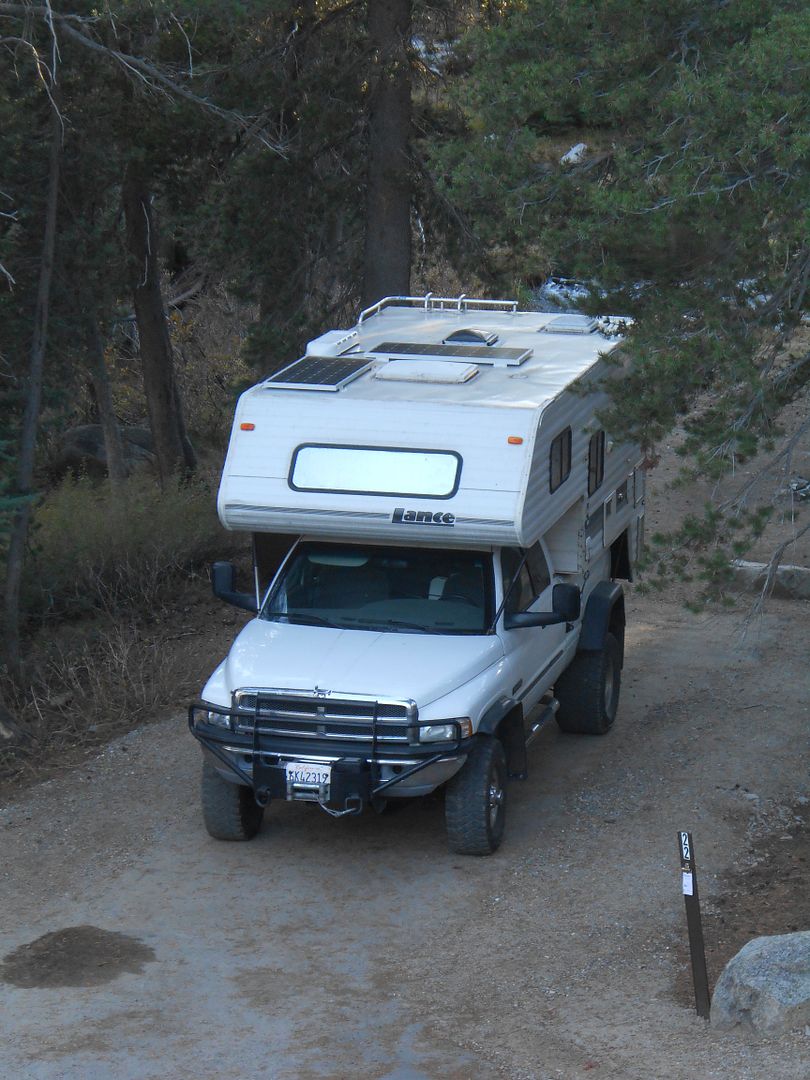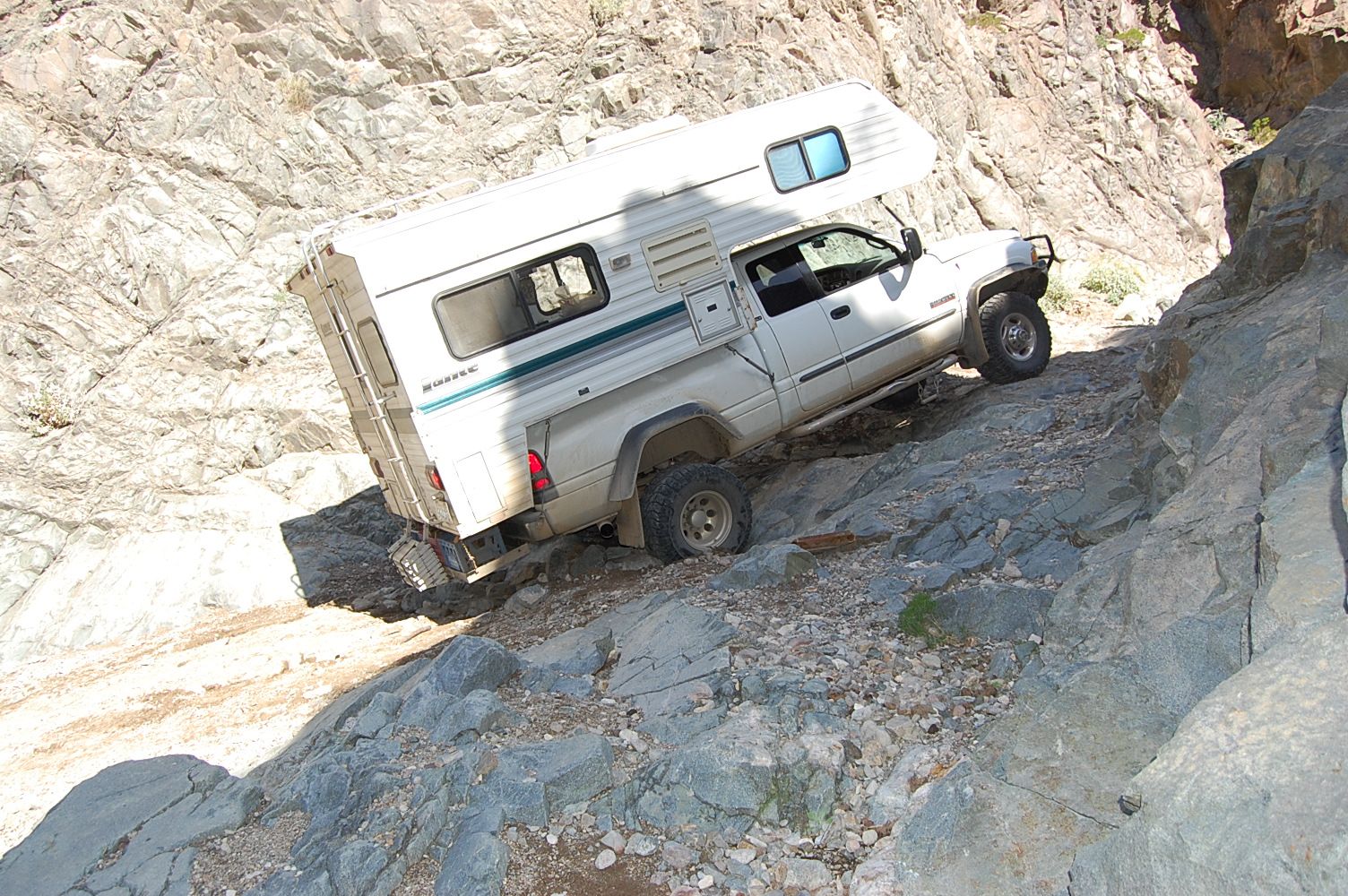Hi Jefe, here is a link that answers a lot of questions in great detail, it's the first one I built with a lot of the research, and testing information. http://forum.expeditionportal.com/threads/143766-Flatbed-and-composite-panel-build-on-Dodge-2500 This particular unit has almost the same floor plan, and specs are as follows:
Lite extrusion perimeter
Polypropylene honeycomb core (38 mm) with 1.5 mm Crane FRP skins
Fully bonded construction
42 gallon water capacity
15 gallon grey capacity (approx)
Wet bath with Thetford C200 cassette toilet
Espar endless hot water with hydronic heating
Wallas diesel cook top
Wallas 10 liter dedicated fuel tank
2 Group 31 AGM batteries
2000 watt inverter charger
320 watts of solar
Additional overhead storage in overhead and over dinette
Seitz windows
Heki skylights
Bullfinch outside shower
The camper itself equipped as above weighs in at 2816 lbs. So not that heavy considering the back wall to the front wall is 10', and there is 8 1/2' on the floor, 7' wide, and the the overhead is very comfy and bed is north/south, a king mattress will fit in the overhead. I will admit it's a bit on the physically big side, but was originally designed on my end to replace my F-650 with a 17' long body with a full slide, it was close but not close enough. It did accomplish a very roomy and comfortable interior, at 6'1" the wet bath is roomy and my head doesn't hit the ceiling. If you go through the original build thread, you can see the benefits of the extrusion, especially in a camper. The strength of the corners lets us do a lot of things, like remove it from the truck, and live in it while supported on the jacks. It allows easy anchorage for anything you may want to attach, and very easy to do so. Combining the extrusions with quality composites and adhesives eliminates pressure points created by mechanical fasteners which can create some issues, and vibration is dampened. It's not the only way to build something but it's our way. The flat beds on pick up trucks are mounted solid to all factory mounting locations, modern pick ups have very rigid frames and every generation change has been getting stiffer, we test a lot of truck frames destructively when we develop ROPS for mining and exploration and we get a lot of data from those tests (we have a 100 ton hydraulic press that you can put a full size truck in), as well for these particular applications we do a few more evaluations that mimic rough road travel. The Dodge frame is very rigid, the GM has proven to be the most rigid, even the GM 1500 has a very rigid frame. The new Ford Super Duty has been really beefed up too, we haven't tested a pick up yet. When we mount a flat bed to a cab chassis, we incorporate spring mounts on the front, and shear plate the rear, the frame from the front of the rear spring hangers to the rear of the frame is very rigid, and most of the flex occurs from the spring hangers forward, hence solid mounting the rear. Camper or body weight and height plays a big part in the amount of spring tension and travel in those parts, as well rigidity of the camper or body comes into play, our body is very rigid and some torque can actually be transmitted through the body without issue. We can only get results like we have by designing and building the whole package, and road miles, when there is an unknown it usually surfaces at some time and usually unfavorably. The latches we designed clamp down with 550 pounds of force per unit and also have an inch of allowable movement in them, and assist in fast removal and reloading without any tools. You cannot put more or less pressure on them, or the mounts. The deck surface is 1/2" rubber, over .188 aluminum plate with proper support underneath.
I hope this answered some questions, we are always open to observation and comments, other people have really good ideas and experience too!
Lite extrusion perimeter
Polypropylene honeycomb core (38 mm) with 1.5 mm Crane FRP skins
Fully bonded construction
42 gallon water capacity
15 gallon grey capacity (approx)
Wet bath with Thetford C200 cassette toilet
Espar endless hot water with hydronic heating
Wallas diesel cook top
Wallas 10 liter dedicated fuel tank
2 Group 31 AGM batteries
2000 watt inverter charger
320 watts of solar
Additional overhead storage in overhead and over dinette
Seitz windows
Heki skylights
Bullfinch outside shower
The camper itself equipped as above weighs in at 2816 lbs. So not that heavy considering the back wall to the front wall is 10', and there is 8 1/2' on the floor, 7' wide, and the the overhead is very comfy and bed is north/south, a king mattress will fit in the overhead. I will admit it's a bit on the physically big side, but was originally designed on my end to replace my F-650 with a 17' long body with a full slide, it was close but not close enough. It did accomplish a very roomy and comfortable interior, at 6'1" the wet bath is roomy and my head doesn't hit the ceiling. If you go through the original build thread, you can see the benefits of the extrusion, especially in a camper. The strength of the corners lets us do a lot of things, like remove it from the truck, and live in it while supported on the jacks. It allows easy anchorage for anything you may want to attach, and very easy to do so. Combining the extrusions with quality composites and adhesives eliminates pressure points created by mechanical fasteners which can create some issues, and vibration is dampened. It's not the only way to build something but it's our way. The flat beds on pick up trucks are mounted solid to all factory mounting locations, modern pick ups have very rigid frames and every generation change has been getting stiffer, we test a lot of truck frames destructively when we develop ROPS for mining and exploration and we get a lot of data from those tests (we have a 100 ton hydraulic press that you can put a full size truck in), as well for these particular applications we do a few more evaluations that mimic rough road travel. The Dodge frame is very rigid, the GM has proven to be the most rigid, even the GM 1500 has a very rigid frame. The new Ford Super Duty has been really beefed up too, we haven't tested a pick up yet. When we mount a flat bed to a cab chassis, we incorporate spring mounts on the front, and shear plate the rear, the frame from the front of the rear spring hangers to the rear of the frame is very rigid, and most of the flex occurs from the spring hangers forward, hence solid mounting the rear. Camper or body weight and height plays a big part in the amount of spring tension and travel in those parts, as well rigidity of the camper or body comes into play, our body is very rigid and some torque can actually be transmitted through the body without issue. We can only get results like we have by designing and building the whole package, and road miles, when there is an unknown it usually surfaces at some time and usually unfavorably. The latches we designed clamp down with 550 pounds of force per unit and also have an inch of allowable movement in them, and assist in fast removal and reloading without any tools. You cannot put more or less pressure on them, or the mounts. The deck surface is 1/2" rubber, over .188 aluminum plate with proper support underneath.
I hope this answered some questions, we are always open to observation and comments, other people have really good ideas and experience too!


